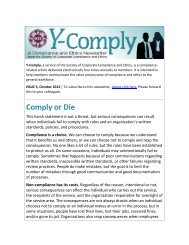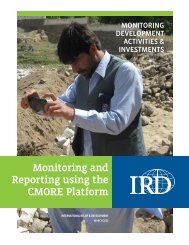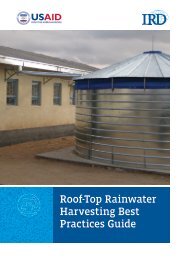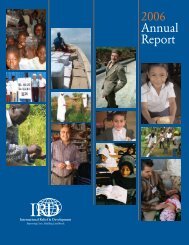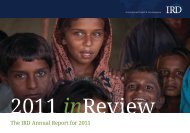Empowering citizens Engaging governments Rebuilding communities
Empowering citizens Engaging governments Rebuilding communities
Empowering citizens Engaging governments Rebuilding communities
Create successful ePaper yourself
Turn your PDF publications into a flip-book with our unique Google optimized e-Paper software.
“Stabilization and reconstruction missions occur in a range<br />
of circumstances—sometimes in hostile security environments,<br />
sometimes in permissive ones, and sometimes in<br />
environments somewhere in between. The mission to stabilize<br />
and reconstruct a nation is one that civilians must lead.”<br />
— John Negroponte<br />
Following the September 11, 2001, terrorist attacks<br />
and subsequent US military operations in Afghanistan<br />
and Iraq, traditional relief and development programs,<br />
historically the province of a small group of civilian<br />
and voluntary agencies, expanded dramatically in<br />
scale and scope, touching nearly every government<br />
department, including the US military. Whereas the<br />
primary focus of assistance operations generally had<br />
been centered on providing humanitarian aid, rebuilding<br />
services, and enhancing civil society, the evolving<br />
efforts reached beyond basic relief measures, aiming<br />
to stabilize and rebuild populations during a period of<br />
conflict and, in some instances, while military operations<br />
were ongoing.<br />
At the same time that the US government was expanding<br />
into stabilization operations, American military<br />
leadership, informed by the ongoing wars in Iraq and<br />
Afghanistan, was recognizing its own need—and current<br />
structural limitations—in these areas. In 2006, the US<br />
Army and Marine Corps released a new field manual<br />
covering counterinsurgency operations, the first time<br />
in more than two decades that either had addressed<br />
counterinsurgency (COIN) exclusively in a manual. The<br />
primary purpose of the document was to lay out a<br />
blueprint for the military’s approach to a more contemporary<br />
form of warfare, an approach that General David<br />
Petraeus, one of the manual’s chief authors, recognized<br />
as inextricably tied to nonmilitary resources.<br />
A counterinsurgency campaign, Petraeus wrote,<br />
requires soldiers and marines “to employ a mix of<br />
familiar combat tasks and skills more often associated<br />
with nonmilitary agencies” and to be prepared<br />
for “extensive coordination and cooperation with many<br />
intergovernmental, host-nation, and international agencies.”<br />
The second chapter of the manual is devoted<br />
to integrating civilian and military activities, beginning<br />
with a kind of acquiescence to the limits of industrial<br />
might in unstable environments. Military efforts are<br />
necessary to fight insurgents, the manual states, but<br />
they are only effective when integrated into a larger<br />
strategy intended to meet the needs of the local<br />
population and win community support.<br />
Testifying before Congress in 2008, John Negroponte,<br />
the US ambassador to Iraq (2004–05), noted there<br />
had been 17 “significant” stabilization and reconstruction<br />
missions over the preceding 20 years in which<br />
“too much of the effort was borne by our men and<br />
women in uniform.” Negroponte was lobbying for<br />
State Department funding for what would become<br />
the Civilian Response Corps, but the message was<br />
clear—despite greater need, neither the military<br />
1


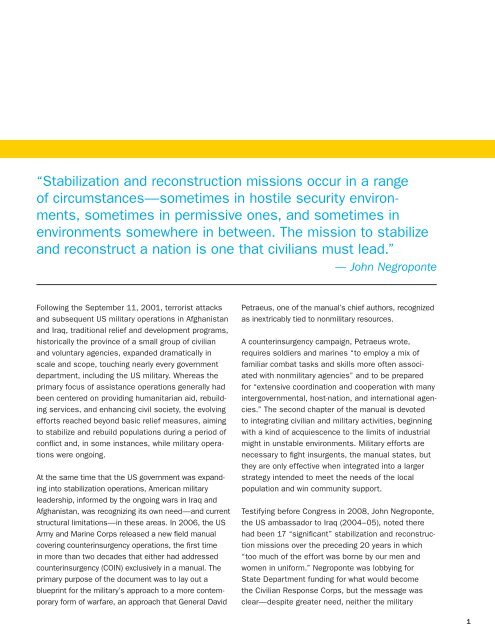
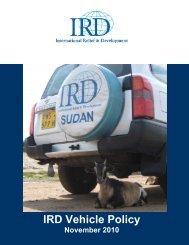
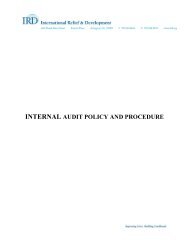
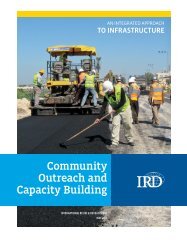
![Guide bonne pratique production d'oignon qualité_VF_4_2411012[1]](https://img.yumpu.com/23506639/1/184x260/guide-bonne-pratique-production-doignon-qualitac-vf-4-24110121.jpg?quality=85)

